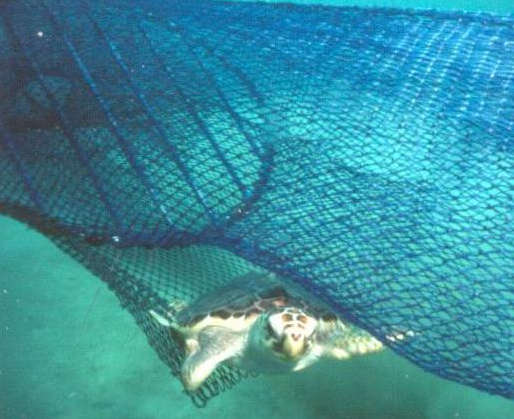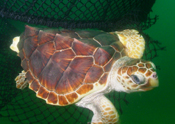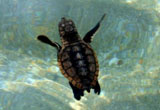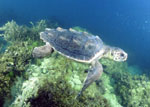Loggerhead Turtle (Caretta caretta)
Status | Taxonomy | Species Description | Habitat | Distribution |
Population Trends | Threats | Conservation Efforts | Regulatory Overview |
Key Documents | More Info
Status
ESA Threatened - throughout its range
Taxonomy
Kingdom: Animalia
Phylum: Chordata
Class: Reptilia
Order: Testudines
Family: Cheloniidae
Genus: Caretta
Species: caretta
Species Description
Loggerheads were named for their relatively large heads, which support powerful jaws and enable them to feed on hard-shelled prey, such as whelks and conch. The carapace (top shell) is slightly heart-shaped and reddish-brown in adults and sub-adults, while the plastron (bottom shell) is generally a pale yellowish color. The neck and flippers are usually dull brown to reddish brown on top and medium to pale yellow on the sides and bottom. Mean straight carapace length of adults in the southeastern U.S. is approximately 36 in (92 cm); corresponding weight is about 250 lbs (113 kg).
Loggerheads reach sexual maturity at around 35 years of age. In the southeastern U.S., mating occurs in late March to early June and females lay eggs between late April and early September. Females lay three to five nests, and sometimes more, during a single nesting season. The eggs incubate approximately two months before hatching sometime between late June and mid-November.
Hatchlings vary from light to dark brown to dark gray dorsally and lack the reddish-brown coloration of adults and juveniles. Flippers are dark gray to brown above with white to white-gray margins. The coloration of the plastron is generally yellowish to tan. At emergence, hatchlings average 1.8 in (45 mm) in length and weigh approximately 0.04 lbs (20 g).
Habitat
Loggerheads occupy three different ecosystems during their lives--the terrestrial zone, the oceanic zone, and the "neritic" zone. Loggerheads nest on ocean beaches, generally preferring high energy, relatively narrow, steeply sloped, coarse-grained beaches. Immediately after hatchlings emerge from the nest, they begin a period of frenzied activity. During this active period, hatchlings move from their nest to the surf, swim and are swept through the surf zone, and continue swimming away from land for about one to several days.
After this swim frenzy period, post-hatchling loggerheads take up residence in areas where surface waters converge to form local downwellings. These areas are often characterized by accumulations of floating material, such as seaweed (e.g., Sargassum), and, in the southeast U.S., are common between the Gulf Stream and the southeast U.S. coast, and between the Loop Current and the Gulf Coast of Florida. Post-hatchlings within this habitat are observed to be low-energy float-and-wait foragers that feed on a wide variety of floating items (Witherington 2002). As post-hatchlings, loggerheads may linger for months in waters just off the nesting beach or become transported by ocean currents within the Gulf of Mexico and North Atlantic. Work by Lohmann and Lohmann (1994b, 1996) and Lohmann et al. (1999) suggests that loggerheads may continue some oriented swimming in order to keep from being swept into cold North Atlantic currents.
Once individuals get transported by ocean currents farther offshore, they've entered the oceanic zone. Within the North Atlantic, juvenile loggerheads have been primarily studied in the waters around the Azores and Madeira (Bolten 2003). Other populations exist (e.g., in the region of the Grand Banks off Newfoundland), but data on these populations are limited. The juvenile turtles around the Azores and Madeira spend the majority of their time in the top 15 feet (5 m) of the water column.
Somewhere between the ages of 7 to 12 years, oceanic juveniles migrate to nearshore coastal areas (neritic zone) and continue maturing until adulthood. In addition to providing critically important habitat for juveniles, the neritic zone also provides crucial foraging habitat, inter-nesting habitat, and migratory habitat for adult loggerheads in the western North Atlantic. To a large extent, these habitats overlap with the juvenile stage, the exception being most of the bays, sounds, and estuaries along the Atlantic and Gulf coasts of the U.S. from Massachusetts to Texas, which are infrequently used by adults. However, adult loggerheads are present year-round in Florida Bay, an important feeding area, probably because of relatively easy access to open ocean and migratory routes. The predominate foraging areas for western North Atlantic adult loggerheads are found throughout the relatively shallow continental shelf waters of the U.S., Bahamas, Cuba, and the Yucatán Peninsula, Mexico. Migration routes from foraging habitats to nesting beaches (and vice versa) for a portion of the population are restricted to the continental shelf, while other routes involve crossing oceanic waters to and from the Bahamas, Cuba, and the Yucatán Peninsula. Seasonal migrations of adult loggerheads along the mid- and southeast U.S. coasts have also been documented.
Distribution
Loggerheads are circumglobal, occurring throughout the temperate and tropical regions of the Atlantic, Pacific, and Indian Oceans. Loggerheads are the most abundant species of sea turtle found in U.S. coastal waters.
In the Atlantic, the loggerhead turtle's range extends from Newfoundland to as far south as Argentina. During the summer, nesting occurs primarily in the subtropics. Although the major nesting concentrations in the U.S. are found from North Carolina through southwest Florida, minimal nesting occurs outside of this range westward to Texas and northward to southern Virginia. Adult loggerheads are known to make extensive migrations between foraging areas and nesting beaches. During non-nesting years, adult females from U.S. beaches are distributed in waters off the eastern U.S. and throughout the Gulf of Mexico, Bahamas, Greater Antilles, and Yucatán.
The majority of loggerhead nesting occurs in the western rims of the Atlantic and Indian Oceans. The loggerhead nesting aggregations in Oman, the U.S., and Australia account for about 88% of nesting worldwide. In the southeastern U.S., about 80% of loggerhead nesting occurs in six Florida counties (Brevard, Indian River, St. Lucie, Martin, Palm Beach, and Broward Counties). In Brevard and Indian River Counties, a 20 mile (32.2 km) section of coastline from Melbourne Beach to Wabasso Beach comprises the Archie Carr National Wildlife Refuge (ACNWR). ACNWR is the most important nesting area for loggerhead turtles in the western hemisphere. Twenty-five percent of all loggerhead nesting in the U.S. occurs in the Refuge. Researchers have recorded nesting densities of 1,000 nests per mile (625 nests per km) within the ACNWR.
In the eastern Pacific, loggerheads have been reported as far north as Alaska, and as far south as Chile. In the U.S., occasional sightings are reported from the coasts of Washington and Oregon, but most records are of juveniles off the coast of California. The west coast of Mexico, including the Baja Peninsula, provides critically important developmental habitats for juvenile loggerheads. The only known nesting areas for loggerheads in the North Pacific are found in southern Japan.
Population Trends
The most recent reviews show that only two loggerhead nesting beaches have greater than 10,000 females nesting per year: South Florida (U.S.) and Masirah Island (Oman). The status of the Oman nesting colony has not been evaluated recently. Total estimated nesting in the U.S. is approximately 68,000 to 90,000 nests per year. Recent analyses of nesting data from the Index Nesting Beach Survey program in southeast Florida show the population is declining. Similarly, long-term nesting data show loggerhead nesting declines in North Carolina, South Carolina, and Georgia.
In the Eastern Atlantic, the Cape Verde Islands support an intermediately-sized loggerhead nesting assemblage. In 2000, researchers tagged over 1,000 nesting females on just 5 km (3.1 mi) of beach on Boavista Island (Ehrhart et al. 2003). In the Western Atlantic (excluding the U.S.), Brazil supports an intermediately-sized loggerhead nesting assemblage. Published and unpublished reports provide an estimate of about 4,000 nests per year in Brazil (Ehrhart et al. 2003). Loggerhead nesting throughout the Caribbean is sparse.
In the Mediterranean, loggerhead nesting is confined almost exclusively to the eastern portion of the Mediterranean Sea. The main nesting assemblages occur in Cyprus, Greece, and Turkey. However, small numbers of loggerhead nests have been recorded in Egypt, Israel, Italy, Libya, Syria, and Tunisia. Based on the recorded number of nests per year in Cyprus, Greece, Israel, Tunisia, and Turkey, loggerhead nesting in the Mediterranean ranges from about 3,300 to 7,000 nests per season (Margaritoulis et al. 2003).
Loggerheads nest throughout the Indian Ocean and, with the exception of Oman, the number of nesting females is small. Most trends in loggerhead nesting populations in the Indian Ocean are unknown.
Loggerhead populations in Honduras, Mexico, Colombia, Israel, Turkey, Bahamas, Cuba, Greece, Japan, and Panama have been declining. This decline continues and is primarily attributed to incidental capture in fishing gear, directed harvest, coastal development, increased human use of nesting beaches, and pollution.
 Loggerhead Turtle escaping a trawl net equipped with turtle excluder device (TED) (Caretta caretta) Photo: NOAA |
Threats
Loggerheads face threats on both nesting beaches and in the marine environment. The greatest cause of decline and the continuing primary threat to loggerhead turtle populations worldwide is incidental capture in fishing gear, primarily in longlines and gillnets, but also in trawls, traps and pots, and dredges. Directed harvest for loggerheads still occurs in many places (e.g., the Bahamas, Cuba, and Mexico) and is a serious and continuing threat to loggerhead recovery. For more information, please visit our threats to marine turtles page.
Conservation Efforts
The highly migratory behavior of loggerheads makes them shared resources among many nations. Therefore, conservation efforts for loggerhead populations in one country may be jeopardized by activities in another. Protecting loggerhead sea turtles on U.S. nesting beaches and in U.S. waters alone is not sufficient to ensure the continued existence of the species.
Loggerhead turtles are protected by various international treaties and agreements as well as national laws. They are listed in Appendix I of the Convention on International Trade in Endangered Species of Wild Flora and Fauna (CITES), which means that international trade of this species is prohibited. Loggerheads are listed in Appendices I and II of the Convention on Migratory Species (CMS ![]() ) and are protected under the following auspices of CMS: the Memorandum of Understanding on the Conservation and Management of Marine Turtles and their Habitats of the Indian Ocean and South-East Asia (IOSEA) and the Memorandum of Understanding Concerning Conservation Measures for Marine Turtles of the Atlantic Coast of Africa. Loggerheads are also protected under Annex II of the Specially Protected Areas and Wildlife (SPAW
) and are protected under the following auspices of CMS: the Memorandum of Understanding on the Conservation and Management of Marine Turtles and their Habitats of the Indian Ocean and South-East Asia (IOSEA) and the Memorandum of Understanding Concerning Conservation Measures for Marine Turtles of the Atlantic Coast of Africa. Loggerheads are also protected under Annex II of the Specially Protected Areas and Wildlife (SPAW ![]() ) Protocol of the Cartagena Convention. Additionally, the U.S. is a party to the Inter-American Convention for the Protection and Conservation of Sea Turtles (IAC
) Protocol of the Cartagena Convention. Additionally, the U.S. is a party to the Inter-American Convention for the Protection and Conservation of Sea Turtles (IAC ![]() ), which is the only binding international treaty dedicated exclusively to marine turtles.
), which is the only binding international treaty dedicated exclusively to marine turtles.
In the U.S., NOAA's National Marine Fisheries Service (NMFS) and the U.S. Fish and Wildlife Service (USFWS) have joint jurisdiction for marine turtles, with NMFS having the lead in the marine environment and USFWS having the lead on the nesting beaches. Both federal agencies, and a number of state agencies, have promulgated regulations to eliminate or reduce threats to sea turtles. In the Atlantic and Gulf of Mexico, NMFS has required measures (e.g., gear modifications, changes to fishing practices, and time/area closures) to reduce sea turtle bycatch in pelagic longline, mid-Atlantic gillnet, Chesapeake Bay pound net, and southeast shrimp and flounder trawl fisheries.
NMFS has worked closely with the shrimp trawl fishing industry to develop turtle excluder devices (TEDs) to reduce the mortality of sea turtles incidentally captured in shrimp trawl gear. TEDs that are large enough to exclude even the largest sea turtles are now required in shrimp trawl nets. Since 1989, the U.S. has embargoed shrimp harvested in a manner that adversely affects sea turtles. The import ban does not apply to nations that have adopted sea turtle protection programs comparable to that of the U.S. (e.g., require and enforce the use of TEDs) or to nations where incidental capture in shrimp fisheries does not present a threat to sea turtles (e.g., nations that fish for shrimp in areas where sea turtles do not occur). The U.S. Department of State (DOS) is the principal implementing agency of this law, while NMFS serves as technical advisor. NMFS has provided extensive TED training throughout the world.
In 2003, NMFS developed the Strategy for Sea Turtle Conservation and Recovery in Relation to Atlantic and Gulf of Mexico Fisheries (Strategy) to evaluate and address domestic sea turtle bycatch comprehensively across jurisdictional (i.e., state and Federal) and fishing sector (i.e., commercial and recreational) boundaries on a per-gear basis in fisheries of the Atlantic and Gulf of Mexico.
NMFS is currently involved in cooperative gear research projects designed to reduce sea turtle bycatch in the Gulf of Mexico and Atlantic pelagic longline fisheries, the Hawaii-based deep set longline fishery, the Atlantic sea scallop dredge fishery, the Chesapeake Bay pound net fishery, and non-shrimp trawl fisheries in the Atlantic and Gulf.
In 1991, NMFS and USFWS finalized the recovery plan for loggerheads in the U.S. Caribbean, Atlantic, and Gulf of Mexico. Since that time, a wealth of new information has been gained regarding loggerhead biology, distribution, and population status as well as threats to the species. Therefore, NMFS and USFWS have initiated a draft revision of the loggerhead recovery plan for the U.S. Caribbean, Atlantic, and Gulf of Mexico.
 Loggerhead Turtle escaping a net equipped with turtle excluder device (TED) (Caretta caretta) Photo: NOAA |
Regulatory Overview
The loggerhead turtle was listed under the Endangered Species Act (ESA) as threatened throughout its range on July 28, 1978.
NMFS implements measures to reduce sea turtle interactions in fisheries by regulations and permits under the ESA and Magnuson-Stevens Fishery Conservation and Management Act. In 1992, NMFS finalized regulations to require TEDs in shrimp trawl fisheries to reduce interactions between turtles and trawl gear. Since then, NMFS has modified these regulations as new information became available on increasing the efficiency of TEDs (e.g., larger TEDs are now required to exclude larger turtles). Since the early 1990s, NMFS has implemented sea turtle conservation measures including, but not limited to, TEDs in trawl fisheries, large circle hooks in longline fisheries, time and area closures for gillnets, and modifications to pound net leaders. Click here for a list of NMFS regulations to protect marine turtles.
Key Documents
(All documents are in PDF format.)
| Title | Federal Register | Date |
|---|---|---|
| Draft Recovery Plan for the Northwest Atlantic Population, Second Revision | 73 FR 31066 | 05/30/2008 |
| Memo: Loggerhead Turtle Expert Working Group Update | n/a | 12/04/2007 |
| 5-Year Review | n/a | 08/31/2007 |
| Virginia Pound Net Fishery Regulations | 71 FR 36024 | 06/23/2006 |
| Recovery Plan - U.S. Pacific | 63 FR 28359 | 05/22/1998 |
Status Review of Sea Turtles Listed Under the Endangered Species Act of 1973 |
61 FR 17 | 01/02/1996 |
| TED Regulations for Shrimp Trawls | 57 FR 57348 | 12/04/1992 |
| Recovery Plan - U.S. Caribbean, Atlantic, and Gulf of Mexico | n/a | 10/29/1991 |
| ESA Listing Rule | 43 FR 32800 | 07/28/1978 |
- Kids' Times: Loggerhead Sea Turtle
- NOAA's National Marine Sanctuaries Encyclopedia
- Recovery Plan Revision for the Atlantic Loggerhead
- U.S. Fish and Wildlife Service Loggerhead Turtle Species Profile
- Sea Turtle Recovery Planning
- Marine Turtle Related Links
Literature Cited
- Bolten, A.B. 2003. Active Swimmers - Passive Drifters: The Oceanic Juvenile Stage of Loggerheads in the Atlantic System. Pages 63-78 in Bolten, A.B. and B.E. Witherington (editors). Loggerhead Sea Turtles. Smithsonian Books, Washington D.C.
- Erhart, L.M., D.A. Bagley, and W.E. Redfoot. 2003. Loggerhead Turtles in the Atlantic Ocean: Geographic Distribution, Abundance, and Population Status. Pages 157-174 in Bolten, A.B. and B.E. Witherington (editors). Loggerhead Sea Turtles. Smithsonian Books, Washington D.C.
- Lohmann, K.J. and C.M.F. Lohmann. 1994b. Detection of magnetic inclination angle by sea turtles: a possible mechanism for determining latitude. Journal of Experimental Biology 194:23-32.
- Lohmann, K.J. and C.M.F. Lohmann. 1996. Orientation and open-sea navigation in sea turtles. Journal of Experimental Biology 199:73-81.
- Lohmann, K.J., J.T. Hester, and C.M.F. Lohmann. 1999. Long-distance navigation in sea turtles. Ethology Ecology & Evolution 11:1-23.
- Margaritoulis, D., R. Argano, I. Baran, F. Bentivegna, M.N. Bradai, J.A. Camiñas, P. Casale, G. De Metrio, A. Demetropoulos, G. Gerosa, B.J. Godley, D.A. Haddoud, J. Houghton, L. Laurent, and B. Lazar. 2003. Loggerhead Turtles in the Mediterranean Sea: Present Knowledge and Conservation Perspectives. Pages 175-198 in Bolten, A.B. and B.E. Witherington (editors). Loggerhead Sea Turtles. Smithsonian Books, Washington D.C.
- Witherington, B.E. 2002. Ecology of neonate loggerhead turtles inhabiting lines of downwelling near a Gulf Stream front. Marine Biology 140:843-853.

